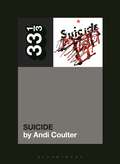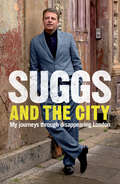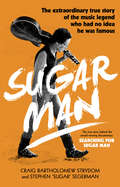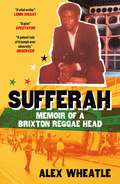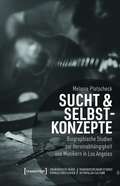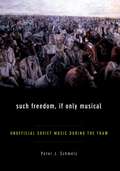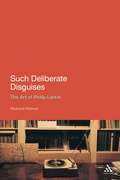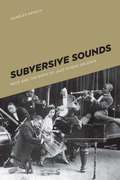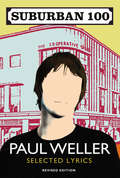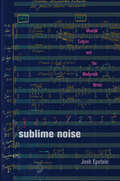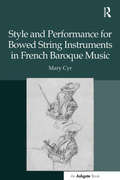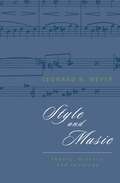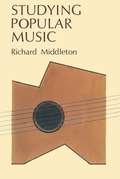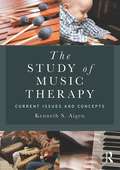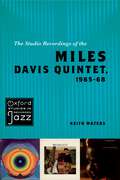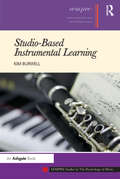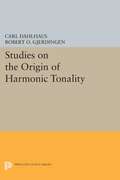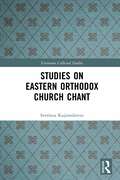- Table View
- List View
Suicide's Suicide (33 1/3 #149)
by Andi CoulterNew York City in the 1970s was an urban nightmare: destitute, dirty, and dangerous. As the country collectively turned its back on the Big Apple, two musical vigilantes rose out of the miasma. Armed only with amplified AC current, Suicide's Alan Vega and Marty Rev set out to save America's soul. Their weaponized noise terrorized unsuspecting audiences. Suicide could start a riot on a lack of guitar alone. Those who braved their live shows often fled in fear--or formed bands (sometimes both). This book attempts to give the reader a front-row seat to a Suicide show. Suicide is one of the most original, most misunderstood, and most influential bands of the last century. While Suicide has always had a dedicated cult following, the band is still relatively unknown outside their musical coterie. Arguing against the idea of the band's niche musical history, this book looks at parallels between Marvel Comics' antiheroes in the 1970s and Suicide's groundbreaking first album. Andi Coulter tells the origin story of two musical Ghost Riders learning to harness their sonic superpower, using noise like a clarion call for a better future.
Suggs and the City: Journeys through Disappearing London
by SuggsRevelling in the off-beat and eccentric, Londoner Suggs takes us on a nostalgic adventure to explore the disappearing history of his extraordinary home town: from the sharp tailors of Saville Row to the sex traders of Bohemian Soho, by way of quaint and quirky habitats, brilliant but endangered boozers, unique eateries that have introduced the capital to the world's finest foods and a music scene that's dear to his heart.
Sugar Man: The Life, Death and Resurrection of Sixto Rodriguez
by Craig Bartholomew Strydom Stephen 'Sugar' SegermanIn the summer of 1972, during a compulsory stint in the South African military, Stephen 'Sugar' Segerman heard the music that would forever change his life. A decade later, on yet another military base, Craig Bartholomew Strydom heard the same music. It would have a profound effect. Who was this folk singer who resonated with South Africa's youth? No one could say. All that anyone knew was his name - Rodriguez - and the fact that he had killed himself on stage after reading his own epitaph.After many years of searching in a pre-internet age, Strydom with support from Segerman found the musician not dead but alive and living in seclusion in Detroit. Even more remarkable was the fact that Rodriguez, no longer working as a musician and struggling to eke out a blue-collar existence, had no idea that he had been famous for over 25 years in a remote part of the world...
Sufferah: Memoir of a Brixton Reggae Head
by Alex Wheatle"One of the big memoirs of the summer" i news"Alex is a truly gifted storyteller, and the way he details his own story here is no exception" JEFFREY BOAKYE In this breathtaking memoir, acclaimed writer Alex Wheatle shows how music became his salvation through a childhood marred by abuse.Abandoned as a baby to the British care system, Alex grows up with no knowledge of his Jamaican parentage or family history. Later, he is inexorably drawn to reggae, his lifeline through disrupted teenage years, the challenges of living as a young Black man in 1980s Britain and his imprisonment for protesting against systemic racism and police brutality.Alex's youth was portrayed in Oscar Award-winning director Steve McQueen's Small Axe series. In Sufferah, he tells his own story, urgently, vividly and unsentimentally. His award-winning fiction - and this memoir - are a call to never give up hope. They remind us that words can be our sustenance, and music our heartbeat. "Alex Wheatle is the real deal; he writes with heart and authenticity, books that make you laugh and worry and cry and hold your breath" KIT DE WAAL"Alex Wheatle is an inspirer. He sheds light in dark places . . . He is a vital writer" LEMN SISSAY"Alex Wheatle writes from a place of honesty and passion" STEVE McQUEEN, director of Small Axe
Sucht & Selbstkonzepte: Biographische Studien zur Heroinabhängigkeit von Musikern in Los Angeles (Transdisziplinäre Popkulturstudien #3)
by Melanie PtatscheckGetreu dem Motto »Sex & Drugs & Rock'n'Roll« scheint der Konsum von Drogen geradezu prototypisch zum Lifestyle vieler Musiker*innen dazuzugehören. Auffällig ist, dass es immer wieder musikalische Vertreter*innen des Typus »Junkie« sind, die zu Weltstars und Ikonen werden. Doch warum ist dieser Lebenswandel und dabei ausgerechnet der Konsum von Heroin so populär (gewesen)? Durch die Rekonstruktion individueller Lebensgeschichten heroinabhängiger Musiker in Los Angeles bestimmt Melanie Ptatscheck nicht nur sozialpsychologische und musikspezifische Suchtfaktoren. Ebenso zeigt sie auf, durch welche individuellen Bedürfnisse und gesellschaftlichen Narrative die Selbstvorstellungen dieser Musiker geprägt sind.
Such Freedom, If Only Musical: Unofficial Soviet Music During the Thaw
by Peter J SchmelzFollowing Stalin's death in 1953, during the period now known as the Thaw, Nikita Khrushchev opened up greater freedoms in cultural and intellectual life. A broad group of intellectuals and artists in Soviet Russia were able to take advantage of this, and in no realm of the arts was this perhaps more true than in music. Students at Soviet conservatories were at last able to use various channels--many of questionable legality--to acquire and hear music that had previously been forbidden, and visiting performers and composers brought young Soviets new sounds and new compositions. In the 1960s, composers such as Andrey Volkonsky, Edison Denisov, Alfred Schnittke, Arvo Pärt, Sofia Gubaidulina, and Valentin Silvestrov experimented with a wide variety of then new and unfamiliar techniques ranging from serialism to aleatory devices, and audiences eager to escape the music of predictable sameness typical to socialist realism were attracted to performances of their new and unfamiliar creations. This "unofficial" music by young Soviet composers inhabited the gray space between legal and illegal. Such Freedom, If Only Musical traces the changing compositional styles and politically charged reception of this music, and brings to life the paradoxical freedoms and sense of resistance or opposition that it suggested to Soviet listeners. Author Peter J. Schmelz draws upon interviews conducted with many of the most important composers and performers of the musical Thaw, and supplements this first-hand testimony with careful archival research and detailed musical analyses. The first book to explore this period in detail, Such Freedom, If Only Musical will appeal to musicologists and theorists interested in post-war arts movements, the Cold War, and Soviet music, as well as historians of Russian culture and society.
Such Deliberate Disguises: The Art Of Philip Larkin
by Richard PalmerSuch Deliberate Disguises: The Art of Philip Larkin argues that a true understanding of Philip Larkin as man and poet lies beyond his enduring public appeal and the variety of criticism that has recently been applied to his work. Richard Palmer suggests that the ostensible simplicity of Larkin's writing, which continues to attract so many readers to him, is deceptive, masking as it does one of the richest and most resonant of oeuvres in twentieth-century poetry. Penetrating the many masks of Larkin, the book sheds new and considerable light on the hitherto largely ignored spiritual significance of his work. Based upon close and scrupulous reading of the poems themselves, it draws upon insights gained from the history of art and the study of religion and myth as much as literary criticism and personal biography. It also brings long-overdue attention to what is seen to be perhaps the chief love, and operative aesthetic force, of Larkin's life: jazz. Such Deliberate Disguises is thus a major contribution, not just to Larkin studies, but to the wider cultural history of our times.
Subversive Sounds: Race and the Birth of Jazz in New Orleans (Studies In Communication, Media, And Public Opinion Ser.)
by Charles B. HerschSubversive Sounds probes New Orleans’s history, uncovering a web of racial interconnections and animosities that was instrumental to the creation of a vital American art form—jazz. Drawing on oral histories, police reports, newspaper accounts, and vintage recordings, Charles Hersch brings to vivid life the neighborhoods and nightspots where jazz was born. This volume shows how musicians such as Jelly Roll Morton, Nick La Rocca, and Louis Armstrong negotiated New Orleans’s complex racial rules to pursue their craft and how, in order to widen their audiences, they became fluent in a variety of musical traditions from diverse ethnic sources. These encounters with other music and races subverted their own racial identities and changed the way they played—a musical miscegenation that, in the shadow of Jim Crow, undermined the pursuit of racial purity and indelibly transformed American culture. “More than timely . . . Hersch orchestrates voices of musicians on both sides of the racial divide in underscoring how porous the music made the boundaries of race and class.”—New Orleans Times-Picayune
Subversive Sounds: Race and the Birth of Jazz in New Orleans
by Charles B. HerschSubversive Sounds probes New Orleans’s history, uncovering a web of racial interconnections and animosities that was instrumental to the creation of a vital American art form—jazz. Drawing on oral histories, police reports, newspaper accounts, and vintage recordings, Charles Hersch brings to vivid life the neighborhoods and nightspots where jazz was born. This volume shows how musicians such as Jelly Roll Morton, Nick La Rocca, and Louis Armstrong negotiated New Orleans’s complex racial rules to pursue their craft and how, in order to widen their audiences, they became fluent in a variety of musical traditions from diverse ethnic sources. These encounters with other music and races subverted their own racial identities and changed the way they played—a musical miscegenation that, in the shadow of Jim Crow, undermined the pursuit of racial purity and indelibly transformed American culture. “More than timely . . . Hersch orchestrates voices of musicians on both sides of the racial divide in underscoring how porous the music made the boundaries of race and class.”—New Orleans Times-Picayune
Subversive Sounds: Race and the Birth of Jazz in New Orleans (Studies In Communication, Media, And Public Opinion)
by Charles B. HerschSubversive Sounds probes New Orleans’s history, uncovering a web of racial interconnections and animosities that was instrumental to the creation of a vital American art form—jazz. Drawing on oral histories, police reports, newspaper accounts, and vintage recordings, Charles Hersch brings to vivid life the neighborhoods and nightspots where jazz was born. This volume shows how musicians such as Jelly Roll Morton, Nick La Rocca, and Louis Armstrong negotiated New Orleans’s complex racial rules to pursue their craft and how, in order to widen their audiences, they became fluent in a variety of musical traditions from diverse ethnic sources. These encounters with other music and races subverted their own racial identities and changed the way they played—a musical miscegenation that, in the shadow of Jim Crow, undermined the pursuit of racial purity and indelibly transformed American culture. “More than timely . . . Hersch orchestrates voices of musicians on both sides of the racial divide in underscoring how porous the music made the boundaries of race and class.”—New Orleans Times-Picayune
Suburban 100: Selected Lyrics
by Paul WellerREVISED, UPDATED AND WITH A NEW FOREWORD BY PAUL ABBOTTThis edition of Suburban 100 includes new lyrics from the critically acclaimed albums, 22 Dreams and Wake Up the Nation, which has been nominated for the Mercury Music Award.Paul Weller first burst onto the national music scene with The Jam in 1977 and was quickly marked apart from his contemporaries as a brilliant lyricist. In a writing career that has now spanned three decades, his songs have been acclaimed, imitated and loved by many. Suburban 100 - the first selection of Paul Weller's lyrics - draws on songs written for The Jam, The Style Council and solo releases that, together, tell stories of life and love, rage and romance. The youthful frustrations of small-town life that fuelled Weller's early writing is palpable, as is the angry but poignant response to Thatcher's Britain. His lyrics, rooted in English suburban culture, explore the hopes, dreams and crashing disappointments of ordinary people. They also revel in the mystical beauty of the English country landscape and repeatedly revisit dreamlike childhood summers.For the first time Paul Weller shares his reflections on his lyrics, offering candid insights to his writing process and the inspiration behind some of pop music's best loved songs. Suburban 100 reveals aspects of a famously private man.
Sublime Noise: Musical Culture and the Modernist Writer (Hopkins Studies in Modernism)
by Josh EpsteinWhen Stravinsky’s Rite of Spring premiered in Paris in 1913, the crowd rioted in response to the harsh dissonance and jarring rhythms of its score. This was noise, not music. In Sublime Noise, Josh Epstein examines the significance of noise in modernist music and literature. How—and why—did composers and writers incorporate the noises of modern industry, warfare, and big-city life into their work?Epstein argues that, as the creative class engaged with the racket of cityscapes and new media, they reconsidered not just the aesthetic of music but also its cultural effects. Noise, after all, is more than a sonic category: it is a cultural value judgment—a way of abating and categorizing the sounds of a social space or of new music. Pulled into dialogue with modern music’s innovative rhythms, noise signaled the breakdown of art’s autonomy from social life—even the "old favorites" of Beethoven and Wagner took on new cultural meanings when circulated in noisy modern contexts. The use of noise also opened up the closed space of art to the pressures of publicity and technological mediation.Building both on literary cultural studies and work in the "new musicology," Sublime Noise examines the rich material relationship that exists between music and literature. Through close readings of modernist authors, including James Joyce, T. S. Eliot, Edith Sitwell, E. M. Forster, and Ezra Pound, and composers, including George Antheil, William Walton, Erik Satie, and Benjamin Britten, Epstein offers a radically contemporary account of musical-literary interactions that goes well beyond pure formalism. This book will be of interest to scholars of Anglophone literary modernism and to musicologists interested in how music was given new literary and cultural meaning during that complex interdisciplinary period.
Sublime Noise: Musical Culture and the Modernist Writer (Hopkins Studies in Modernism)
by Josh EpsteinWhen Stravinsky’s Rite of Spring premiered in Paris in 1913, the crowd rioted in response to the harsh dissonance and jarring rhythms of its score. This was noise, not music. In Sublime Noise, Josh Epstein examines the significance of noise in modernist music and literature. Howâ€�and whyâ€�did composers and writers incorporate the noises of modern industry, warfare, and big-city life into their work?Epstein argues that, as the creative class engaged with the racket of cityscapes and new media, they reconsidered not just the aesthetic of music but also its cultural effects. Noise, after all, is more than a sonic category: it is a cultural value judgmentâ€�a way of abating and categorizing the sounds of a social space or of new music. Pulled into dialogue with modern music’s innovative rhythms, noise signaled the breakdown of art’s autonomy from social lifeâ€�even the "old favorites" of Beethoven and Wagner took on new cultural meanings when circulated in noisy modern contexts. The use of noise also opened up the closed space of art to the pressures of publicity and technological mediation.Building both on literary cultural studies and work in the "new musicology," Sublime Noise examines the rich material relationship that exists between music and literature. Through close readings of modernist authors, including James Joyce, T. S. Eliot, Edith Sitwell, E. M. Forster, and Ezra Pound, and composers, including George Antheil, William Walton, Erik Satie, and Benjamin Britten, Epstein offers a radically contemporary account of musical-literary interactions that goes well beyond pure formalism. This book will be of interest to scholars of Anglophone literary modernism and to musicologists interested in how music was given new literary and cultural meaning during that complex interdisciplinary period.
Style and Performance for Bowed String Instruments in French Baroque Music
by Mary CyrMary Cyr addresses the needs of researchers, performers, and informed listeners who wish to apply knowledge about historically informed performance to specific pieces. Special emphasis is placed upon the period 1680 to 1760, when the viol, violin, and violoncello grew to prominence as solo instruments in France. Part I deals with the historical background to the debate between the French and Italian styles and the features that defined French style. Part II summarizes the present state of research on bowed string instruments (violin, viola, cello, contrebasse, pardessus de viole, and viol) in France, including such topics as the size and distribution of parts in ensembles and the role of the contrebasse. Part III addresses issues and conventions of interpretation such as articulation, tempo and character, inequality, ornamentation, the basse continue, pitch, temperament, and "special effects" such as tremolo and harmonics. Part IV introduces four composer profiles that examine performance issues in the music of Élisabeth Jacquet de La Guerre, Marin Marais, Jean-Baptiste Barrière, and the Forquerays (father and son). The diversity of compositional styles among this group of composers, and the virtuosity they incorporated in their music, generate a broad field for discussing issues of performance practice and offer opportunities to explore controversial themes within the context of specific pieces.
Style and Performance for Bowed String Instruments in French Baroque Music
by Mary CyrMary Cyr addresses the needs of researchers, performers, and informed listeners who wish to apply knowledge about historically informed performance to specific pieces. Special emphasis is placed upon the period 1680 to 1760, when the viol, violin, and violoncello grew to prominence as solo instruments in France. Part I deals with the historical background to the debate between the French and Italian styles and the features that defined French style. Part II summarizes the present state of research on bowed string instruments (violin, viola, cello, contrebasse, pardessus de viole, and viol) in France, including such topics as the size and distribution of parts in ensembles and the role of the contrebasse. Part III addresses issues and conventions of interpretation such as articulation, tempo and character, inequality, ornamentation, the basse continue, pitch, temperament, and "special effects" such as tremolo and harmonics. Part IV introduces four composer profiles that examine performance issues in the music of Élisabeth Jacquet de La Guerre, Marin Marais, Jean-Baptiste Barrière, and the Forquerays (father and son). The diversity of compositional styles among this group of composers, and the virtuosity they incorporated in their music, generate a broad field for discussing issues of performance practice and offer opportunities to explore controversial themes within the context of specific pieces.
Style and Music: Theory, History, and Ideology
by Leonard B. MeyerLeonard Meyer proposes a theory of style and style change that relates the choices made by composers to the constraints of psychology, cultural context, and musical traditions. He explores why, out of the abundance of compositional possibilities, composers choose to replicate some patterns and neglect others. Meyer devotes the latter part of his book to a sketch-history of nineteenth-century music. He shows explicitly how the beliefs and attitudes of Romanticism influenced the choices of composers from Beethoven to Mahler and into our own time. "A monumental work. . . . Most authors concede the relation of music to its cultural milieu, but few have probed so deeply in demonstrating this interaction."—Choice "Probes the foundations of musical research precisely at the joints where theory and history fold into one another."—Kevin Korsyn, Journal of American Musicological Society "A remarkably rich and multifaceted, yet unified argument. . . . No one else could have brought off this immense project with anything like Meyer's command."—Robert P. Morgan, Music Perception "Anyone who attempts to deal with Romanticism in scholarly depth must bring to the task not only musical and historical expertise but unquenchable optimism. Because Leonard B. Meyer has those qualities in abundance, he has been able to offer fresh insight into the Romantic concept."—Donal Henahan, New York Times
Studying Popular Music (UK Higher Education OUP Humanities & Social Sciences Media, Film & Cultural Studies)
by Richard MiddletonA critical analysis of issues and approaches in a variety of areas, ranging from the political economy of popular music through its history and ethnography to its semiology, aesthetics and ideology. The book focuses on Anglo-American popular music of the last 200 years.
The Study of Music Therapy: Current Issues And Concepts
by Kenneth S. AigenThis book addresses the issues in music therapy that are central to understanding it in its scholarly dimensions, how it is evolving, and how it connects to related academic disciplines. It draws on a multi-disciplinary approach to look at the defining issues of music therapy as a scholarly discipline, rather than as an area of clinical practice. It is the single best resource for scholars interested in music therapy because it focuses on the areas that tend to be of greatest interest to them, such as issues of definition, theory, and the function of social context, but also does not assume detailed prior knowledge of the subject. Some of the topics discussed include defining the nature of music therapy, its relation to current and historical uses of music in human well-being, and considerations on what makes music therapy work. Contemporary thinking on the role of neurological theory, early interaction theory, and evolutionary considerations in music therapy theory are also reviewed. Within each of these areas, the author presents an overview of the development of thinking, discusses contrasting positions, and offers a personalized synthesis of the issue. The Study of Music Therapy is the only book in music therapy that gathers all the major issues currently debated in the field, providing a critical overview of the predominance of opinions on these issues.
The Study of Music Therapy: Current Issues And Concepts
by Kenneth S. AigenThis book addresses the issues in music therapy that are central to understanding it in its scholarly dimensions, how it is evolving, and how it connects to related academic disciplines. It draws on a multi-disciplinary approach to look at the defining issues of music therapy as a scholarly discipline, rather than as an area of clinical practice. It is the single best resource for scholars interested in music therapy because it focuses on the areas that tend to be of greatest interest to them, such as issues of definition, theory, and the function of social context, but also does not assume detailed prior knowledge of the subject. Some of the topics discussed include defining the nature of music therapy, its relation to current and historical uses of music in human well-being, and considerations on what makes music therapy work. Contemporary thinking on the role of neurological theory, early interaction theory, and evolutionary considerations in music therapy theory are also reviewed. Within each of these areas, the author presents an overview of the development of thinking, discusses contrasting positions, and offers a personalized synthesis of the issue. The Study of Music Therapy is the only book in music therapy that gathers all the major issues currently debated in the field, providing a critical overview of the predominance of opinions on these issues.
The Studio Recordings of the Miles Davis Quintet, 1965-68 (Oxford Studies in Recorded Jazz)
by Keith WatersThe "Second Quintet" -- the Miles Davis Quintet of the mid-1960s -- was one of the most innovative and influential groups in the history of the genre. Each of the musicians who performed with Davis--saxophonist Wayne Shorter, pianist Herbie Hancock, bassist Ron Carter, and drummer Tony Williams--went on to a successful career as a top player. The studio recordings released by this group made profound contributions to improvisational strategies, jazz composition, and mediation between mainstream and avant-garde jazz, yet most critical attention has focused instead on live performances or the socio-cultural context of the work. Keith Waters' The Studio Recordings of the Miles Davis Quintet, 1965-68 concentrates instead on the music itself, as written, performed, and recorded. Treating six different studio recordings in depth--ESP, Miles Smiles, Sorcerer, Nefertiti, Miles in the Sky, and Filles de Kilimanjaro--Waters has tracked down a host of references to and explications of Davis' work. His analysis takes into account contemporary reviews of the recordings, interviews with the five musicians, and relevant larger-scale cultural studies of the era, as well as two previously unexplored sources: the studio outtakes and Wayne Shorter's Library of Congress composition deposits. Only recently made available, the outtakes throw the master takes into relief, revealing how the musicians and producer organized and edited the material to craft a unified artistic statement for each of these albums. The author's research into the Shorter archives proves to be of even broader significance and interest, as Waters is able now to demonstrate the composer's original conception of a given piece. Waters also points out errors in the notated versions of the canonical songs as they often appear in the main sources available to musicians and scholars. An indispensible resource, The Miles Davis Quintet Studio Recordings: 1965-1968 is suited for the jazz scholar as well as for jazz musicians and aficionados of all levels.
The Studio Recordings of the Miles Davis Quintet, 1965-68 (Oxford Studies in Recorded Jazz)
by Keith WatersThe "Second Quintet" -- the Miles Davis Quintet of the mid-1960s -- was one of the most innovative and influential groups in the history of the genre. Each of the musicians who performed with Davis--saxophonist Wayne Shorter, pianist Herbie Hancock, bassist Ron Carter, and drummer Tony Williams--went on to a successful career as a top player. The studio recordings released by this group made profound contributions to improvisational strategies, jazz composition, and mediation between mainstream and avant-garde jazz, yet most critical attention has focused instead on live performances or the socio-cultural context of the work. Keith Waters' The Studio Recordings of the Miles Davis Quintet, 1965-68 concentrates instead on the music itself, as written, performed, and recorded. Treating six different studio recordings in depth--ESP, Miles Smiles, Sorcerer, Nefertiti, Miles in the Sky, and Filles de Kilimanjaro--Waters has tracked down a host of references to and explications of Davis' work. His analysis takes into account contemporary reviews of the recordings, interviews with the five musicians, and relevant larger-scale cultural studies of the era, as well as two previously unexplored sources: the studio outtakes and Wayne Shorter's Library of Congress composition deposits. Only recently made available, the outtakes throw the master takes into relief, revealing how the musicians and producer organized and edited the material to craft a unified artistic statement for each of these albums. The author's research into the Shorter archives proves to be of even broader significance and interest, as Waters is able now to demonstrate the composer's original conception of a given piece. Waters also points out errors in the notated versions of the canonical songs as they often appear in the main sources available to musicians and scholars. An indispensible resource, The Miles Davis Quintet Studio Recordings: 1965-1968 is suited for the jazz scholar as well as for jazz musicians and aficionados of all levels.
Studio-Based Instrumental Learning (SEMPRE Studies in The Psychology of Music)
by Kim BurwellIn Studio-Based Instrumental Learning, Kim Burwell investigates the nature of lesson interactions in instrumental teaching and learning. Studio lesson activity is represented as a private interaction, dealing with skill acquisition and reflecting a tradition based in apprenticeship, as well as the personal attributes and intentions of participants. The varied and particular nature of such interaction does not always lend itself well to observation or - when observed - to easy interpretation. This presents particular problems for practitioners wishing to share aspects of professional knowledge, and for researchers seeking to explain the practice. Focusing on a single case study of two clarinet lessons, Burwell uses video observations and interviews to analyse collaborative lesson activity, through the 'rich transcription' of performance, verbal and nonverbal behaviours. The foregrounded lesson interactions are also contextualised by the background consideration of social, cultural and institutional frameworks. The research is aimed a helping to create a framework that can support reflection among practitioners as they continually develop their work, not only experientially - through the tradition of 'vertical transmission' from one musician to another - but collaboratively, through the 'horizontal' sharing of good practice.
Studio-Based Instrumental Learning (SEMPRE Studies in The Psychology of Music)
by Kim BurwellIn Studio-Based Instrumental Learning, Kim Burwell investigates the nature of lesson interactions in instrumental teaching and learning. Studio lesson activity is represented as a private interaction, dealing with skill acquisition and reflecting a tradition based in apprenticeship, as well as the personal attributes and intentions of participants. The varied and particular nature of such interaction does not always lend itself well to observation or - when observed - to easy interpretation. This presents particular problems for practitioners wishing to share aspects of professional knowledge, and for researchers seeking to explain the practice. Focusing on a single case study of two clarinet lessons, Burwell uses video observations and interviews to analyse collaborative lesson activity, through the 'rich transcription' of performance, verbal and nonverbal behaviours. The foregrounded lesson interactions are also contextualised by the background consideration of social, cultural and institutional frameworks. The research is aimed a helping to create a framework that can support reflection among practitioners as they continually develop their work, not only experientially - through the tradition of 'vertical transmission' from one musician to another - but collaboratively, through the 'horizontal' sharing of good practice.
Studies on the Origin of Harmonic Tonality
by Carl Dahlhaus Robert O. GjerdingenCarl Dahlhaus was without doubt the premier musicologist of the postwar generation, a giant whose recent death was mourned the world over. Translated here for the first time, this fundamental work on the development of tonality shows his complete mastery of the theory of harmony. In it Dahlhaus explains the modern concepts of harmony and tonality, reviewing in the process the important theories of Rameau, Sechter, Ftis, Riemann, and Schenker. He contrasts the familiar premises of chordal composition with the lesser known precepts of intervallic composition, the basis for polyphonic music in the late Middle Ages and Renaissance. Numerous quotations from theoretical treatises document how early music was driven forward not by progressions of chords but by simple progressions of intervals.Exactly when did composers transform intervallic composition into chordal composition? Modality into tonality? Dahlhaus provides extensive analyses of motets by Josquin, frottole by Cara and Tromboncino, and madrigals by Monteverdi to demonstrate how, and to what degree, such questions can be answered. In his bold speculations, in his magisterial summaries, in his command of eight centuries of music and writings on music, and in his deep understanding of European history and culture, Carl Dahlhaus sets a standard that will seldom be equalled.Originally published in 1990.The Princeton Legacy Library uses the latest print-on-demand technology to again make available previously out-of-print books from the distinguished backlist of Princeton University Press. These editions preserve the original texts of these important books while presenting them in durable paperback and hardcover editions. The goal of the Princeton Legacy Library is to vastly increase access to the rich scholarly heritage found in the thousands of books published by Princeton University Press since its founding in 1905.
Studies on Eastern Orthodox Church Chant (Variorum Collected Studies)
by Svetlana KujumdzievaThis book focuses on the compilation of the different practices of Eastern Orthodox Chant, looking at the subject through various languages, practices, and liturgical books and letters. The subject of this book is also analysed through newly found, unique material, to provide the entire history of Eastern Orthodox Chant, from the ninth to the nineteenth centuries and approached through a number of different disciplines. The book consists of sixteen topics, grouped in four parts: Studies on Genre, Studies on Liturgical Books, Studies on Distinguished Men of Letters, and Studies on Bulgarian Orthodox Church Chant. The aim of the book is to present the Eastern chant as a phase in the evolution of Mediterranean art, which is the cradle of Graeco-Roman heritage. This complex study brings in a variety of sources to show the purpose of Eastern Orthodox Chant as strengthening the Christian faith during the Middle Ages and the revival of Balkan nationalism in the nineteenth century. This book will appeal to students and scholars alike, interested in liturgical musical books, liturgy, and chant repertory. Likewise, it will be of interest to those engaged in medieval and early modern history, music, and culture.
